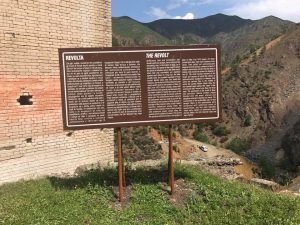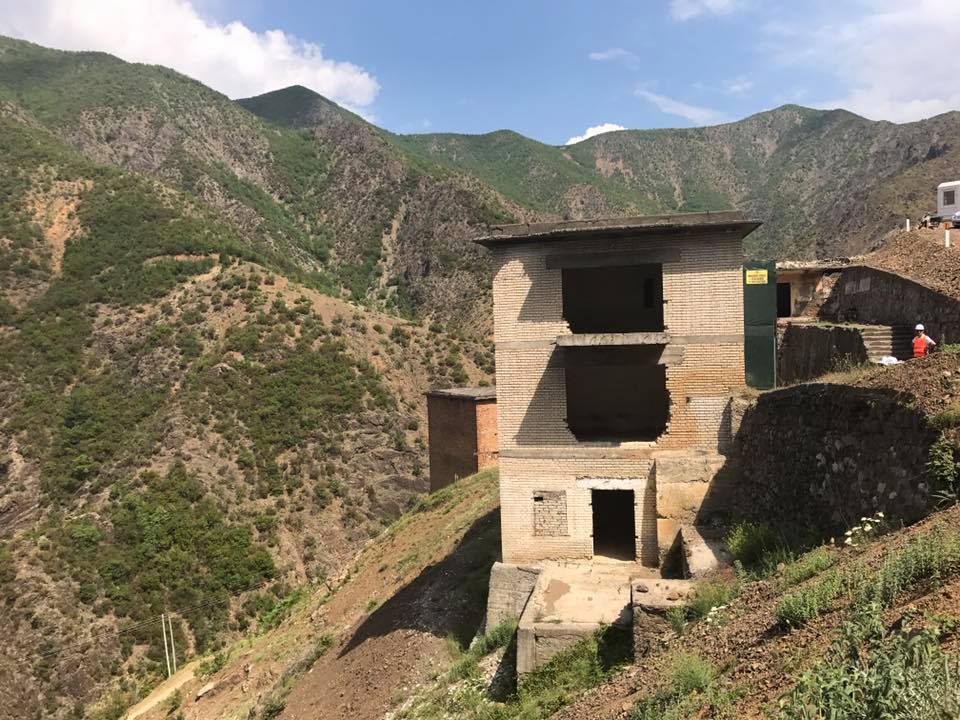
TIRANA, June 6 – An emergency conservation project has been launched on the former notorious Spaৠprison for the politically persecuted under communism while periodic student visits to site target raising awareness among the younger generations of one of the country’s most significant remembrance sites.
The Swedish-government funded project will carry out emergency intervention on the former prison, a protected monument of culture located in northern Albania, about 8 km off Reps village along the Milot-Kukes highway.
The project comes one and a half years after New York-based World Monuments Fund declared the former Spaৠprison as one of the world’s 50 at-risk cultural heritage sites.
A notorious labour camp in communist Albania, the organization described the forgotten site as a powerful place of memory that deserves to be preserved for future generations.
“SpaৠPrison, the notorious labor camp, is in an extremely advanced state of deterioration, and deserves to be transformed into a modern place of remembrance,” said the organization in its 2016 World Monuments Watch.
Culture Minister Mirela Kumbaro describes the conservation project as the second most important step taken on Spaৠafter the site was placed under protection in 2014.
“We have started work on the conservation of the most important remembrance monument, the Spaৠprison, and its remains which resisted time, robbery and forgetfulness,” wrote minister Kumbaro this week.
Sweden-based Cultural Heritage without Borders, which is implementing the conservation project, says preserving Spaৠprison means protecting fundamental rights and democracy.
“Sites of memory like Spaৠenable society to seek justice, acknowledgement and honor for the victims of communist persecution and serve as places of witness and education for the younger generations,” says the CHwB.
“By starting the emergency stabilization works on the remaining buildings of SpaৠPrison, we are taking an important step together to save this site from oblivion and turn it into a place of dialogue and hope,” adds CHwB, the most active cultural heritage NGO operating in the country focused on conservation and restoration.
Earlier this year, Skender Shatku visited Spaৠfor the first time in 25 years after he was released from prison, housing former politically persecuted people accused of agitation and propaganda against the regime until the early 1990s when the communist regime collapsed, paving the way for the closure of the notorious facility.
“We were at the coffee bar when he told us: ‘Wait for me, I will eat, as I don’t want to be there again with an empty stomach.’ Once we arrived he sat on one of the stairs of the prison and said ‘Give me a minute,’ then he started to cry without making a sound,” say ChwB representatives.
The prisoners were used as a working force to mine for minerals and went through heavy psychological and physical torture, fearing for their life every minute of every day.
NGO representatives are also working to introduce Spaৠto younger generations by organized student trips.
“Remembrance sites such as the notorious Spaৠprison, where thousands of Albanians accused as enemies of the regime served their sentence are important especially for the younger generation who are growing with no remembrance and not enough information on the past,” says Jonila Godole, the head of the Institute for Democracy, Media and Culture, organizing regular trips for students and professors to communist remembrance sites.
“The visits to the remains of the former Spaৠprison cannot raise awareness without the presence of witnesses, former inmates who spent a considerable part of their lives there and want to share their stories with youngsters. Their integration gives meaning to Spaৠas a museum site but also their suffering and resistance under dictatorship,” adds Godole, a journalism professor at the University of Tirana.
“We are committed to raising awareness on the importance of these visits to remembrance sites throughout Albania and that they are included in the school curricula as compulsory visits for students attending compulsory education,” she says.
U.S. Ambassador to Albania Donald Lu has also encouraged Albanians to visit Spaà§, which he has described as a “sobering reminder of the sacrifices made by those who fought for freedom.”
“A visit to the prison at Spaৠis a sobering reminder of the sacrifices made by those who fought for freedom and against tyranny, and all too often died in that pursuit,” Ambassador Lu said after a visit to the prison in late 2015.
SpaৠPrison
Spaৠprison was a notorious labor camp established in 1968 by the communist government of Albania at the site of a copper and pyrite mine, in a remote and mountainous area in the center of the country. While only one of many such sites, the political prisoners held at Spaৠincluded some of the most prominent Albanian intellectuals of the twentieth century, granting it a special place in the collective memory of that era, says U.S.-based World Monuments Fund.
The site of the labor camp, on a terraced slope below the tunnel entrances to the mine, was so remote and unforgiving that no perimeter wall was needed to secure the complex, only barbed wire fencing punctuated by occasional guard posts and a front gate. The French-Albanian artist Maks Velo, who was taken into custody in 1978 and sentenced to ten years imprisonment at Spaà§, later described it as “the most terrible camp in Europe and I think in the world during this period.”
In May 1973, SpaৠPrison became the site of a famed prisoners’ revolt, one of the first moments of resistance to the oppression of the regime. Nevertheless, Spaৠcontinued to operate as a labor camp until the fall of the communist party from power in the early 1990s. It was completely abandoned several years later. Today, even though it has been designated as a heritage site, the complex is in an extremely advanced state of deterioration due to the elements and the abandoned and vacant buildings have lost almost all of their fixtures.










